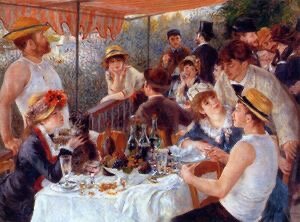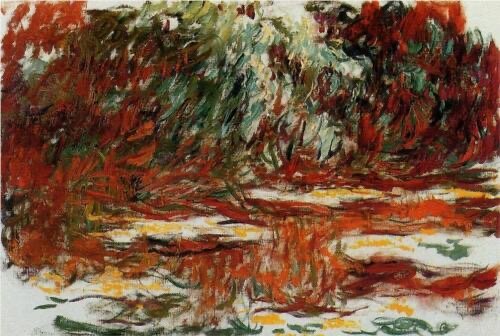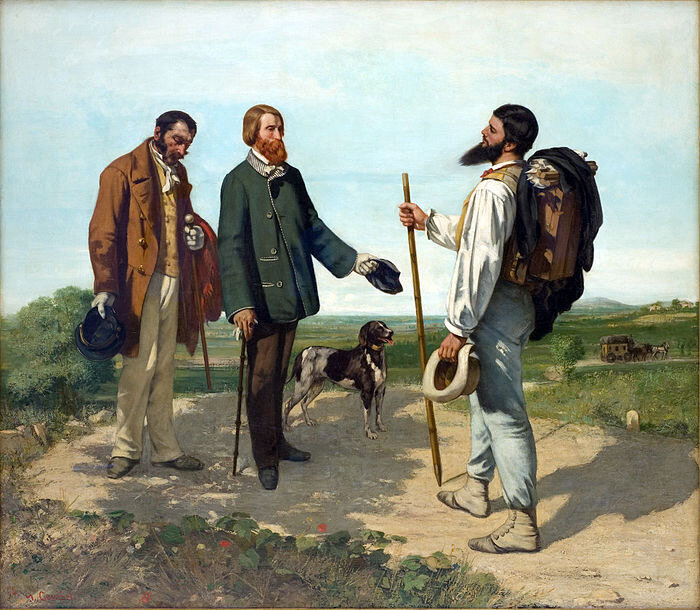Impressions: Renoir at the Art Institute of Chicago
Lunch at the Restaurant Fournaise (1875)
The soft light of mid-afternoon filters through the trellis windows and casts a hazy glow over the terrace. Perhaps this haze is less a product of the dance between sunlight and the humidity and more likely the result of too much good food and wine. The hustle and bustle of clanking tableware and the scrape of chairs is not entirely drowned out by the steady murmur of conversation or the hum of insects in the heat, punctuated by an occasional shout from the boaters gliding along below. A plume of cigarette smoke unfurls in a long curl until it is carried away by the lilting summer breeze, permeating the air with its sweet, warm smell and joining in on the perfume of hot bread, fish, and the stickiness of the outdoors on human skin. We are here, Lunch at the Restaurant Fournaise (1875), just as Renoir, M. de Lauradour, and countless others were blissfully reveling in the lazy afternoon.
i suppose one positive aspect of my move home has been my newfound proximity to Chicago. and, like the persnickety piece of shit i am, i love to take in the Arts. Chicago, being a real city (unlike Detroit—go Sox), is lucky enough to have its own world class collection at the Art Institute (review of the currently featured Andy Warhol exhibit to come ! ). my favorite wing of the museum (other than that of the ancient Egyptian artifacts) is the one spotlighting French Impressionism. Pierre Auguste Renoir is accredited as one of the most notorious and among the most influential French Impressionists of the 19th century. he is also my favorite artist, painting in my absolute favorite style. the primary goal of the Impressionist is to capture the unique, ephemeral beauty of a single instance. it is imperative to first understand Impressionism itself, its definitive meaning, its origins, and the implications that such a movement had on the modern world, in order to deconstruct this work and understand the evolution of Renoir into the revolutionary artist he is known as today. as renoir explained, “In nature, all beauty is irregular.” in the context of his work, it would appear that Renoir is speaking less to imperfection and more of the idea that the most awe-striking effects are created by the fleeting, one-in-a-lifetime entropic confluence of various events. this is what makes Impressionism more akin to photographs. the the effervescent colors and blotchy paint add to their charm, but primarily, I find it much easier to place myself behind the canvas (or even amidst the featured scene).
in spite of his humble beginnings as a porcelain painter’s apprentice, Renoir’s talent became all the more evident as he spent countless hours practicing at the Louvre, studying under master painters, and eventually going on to attend the Écoledes Beaux Arts from, receiving admittance to the prestigious Paris Salon with his submission, La Esmerelda, in 1864. despite earning features of his more traditional efforts in the Paris Salons of 1865, 1868, 1869, and 1870, Renoir found himself identifying less with the practices used by the École des Beaux Arts and more with those of the young artists he had met while under the tutelage of famous painter Charles Gleyre. disillusioned by the rigidity of the Salon, and enamored by the free-spirited sessions en plein air along the banks of the Seine—along with the way these new artists captured light on canvas—Renoir decided to leave the mainstream world of art to join their informal federation of artists, established by none other than Claude Monet. it was during this period of multiple private Impressionist Exhibitions (1874-1874) that Renoir created Lunch at the Restaurant Fournaise (1875), during the heyday of what would come to be known as the Impressionist Movement. Lunch at the Restaurant Fournaise represents a transition in the style of Renoir, from the traditional William Sisley (Figure 12) and the Monet-like Le Grenouillère (Figure 13), to the development of an iconic personal style of portraiture so emotive and convincing its subjects feel almost familiar (Figures 14 and 15).
Impressionism tends to be oversimplified as a style by which an artist creates a rendering of his personal impression or interpretation of a particular scene or subject. similarly, the irregular colors, textures, and shapes featured in Claude Monet’s later canvases (Figure 3) are often attributed only to his oncoming blindness. rather, it would appear that the artist, through the prism of his own impressions, captures the way his subjects have been impressed upon by their surroundings. in this way, the focus of Impressionism becomes less about the artist’s influence over a scene and more about the way in which scene is impacted by its environment, which serve collectively to influence the artist. Monet may have been losing his sight, but this is not the sole factor “coloring” his representation. this sentiment was borne out of a desire to capture the way light affects a scene and the way it is perceived. in the original Impressionist paintings, the artists strived to demonstrate movement in their canvases in the way they portrayed the interaction between light and water. the entire Impressionist movement was founded upon a principle that distinguishes art from reality, in homage to Platonic theory. a piece of art could never fully replicate a real object, only the “appearance of reality”. with this awareness, the artists were able to free themselves from the burden of conveying absolute objectivity in lieu of visceral authenticity, unlike their Classical or Realist predecessors. Classical paintings were too far removed from real life, featuring larger than life, idealized characters and supernatural themes, with which the artist and viewer shared no discernible personal connection (Figure 4). realism had been an effort to encapsulate snapshots of real life, but the artists were so limited by their preconceived notions of conventional reality that their scenes became nothing more than stiff, two-dimensional representations of what they thought they should look like (Figure 5). Impressionism, a middle ground between the ultra-objectivity of Classicism and Realism and the overwhelming subjectivity of Symbolism and—eventually—Modern Art, appears more real because it does not masquerade as something it is not.
The Impressionist method mimics the cognitive process by which everyday objects, which are by no means absolutely uniform, are perceived by the conscious and feeling mind. this is why I love Impressionism, it truly encapsulates the reality that Nature itself is subjective and erratic, constantly changing. prominent writer and thinker of the era, Emile Zola, believed that an artist’s input was all but expected when it came to maintaining authenticity in one’s work, not only because art and “the real” are incompatible, but also because neglecting to do so was simply unnatural. Impressionism was by no means the art du jour. the style rejected the conventional practices set in place by the Écoledes Beaux Arts. the current political climes only reinforced the realness of Impressionism. having suffered detrimental losses to the Hohenzollern army during the Franco-Prussian War, the Second Empire was already in ruins by the time government officials formally declared Napoleon III’s reign to be over. this ended noble influence over popular culture and allowed for the emergence of a new dominating class, the bourgeoisie—a group borne out of the booming industrialization of the day. Impressionism was a new form of art created by and for this developing middle class. for the first time, the patrons of art could see themselves and their daily life immortalized on canvas. this was a departure from the Classical paintings portraying their noble commissioners in ridiculous pomp and circumstance or even the Realist paintings of the working class, which would have been virtually inaccessible to these poorer subjects. these factors account for the increased “realness” of Impressionism, which allowed for an emotional connection between painting and viewer, as the observer could now identify with the motifs taken directly from their own lives and the emotions elicited in the artist that an observer might find also in himself.
in this context, Lunch at the Restaurant Fournaise was executed as a quintessentially Impressionist painting also demonstrating the cultural shifts accompanying the movement. there became an increased interest in sporting and the outdoors among the middle class as the metropolis of Paris became more urban and industrialized. weekend getaways and summer outings were a luxury the emerging bourgeois class was now able to afford. Renoir himself was the quintessential Parisian and bourgeoisie, spending the summer of 1875 in the Parisian suburb of Chatou, off of the River Seine. he painted a series of works during this period featuring the Fournaise family; their restaurant; and the surrounding resort, La Grenouillère; eventually painting over 30 canvases in the area throughout his lifetime. the painting features three main figures in its foreground—real characters one might encounter on a trip to Chatou—a man known to be Monsieur de Lauradour, a frequent guest of the Fournaise restaurant; and a couple, male and female, presumably rowers based upon their casual state of dress. the sun-speckled Seine waters--surrounding the island on which the restaurant is situated--carrying various boats and their inhabitants to and fro, dominate the background. it is this very deliberate placement of lighting that appears to animate the water and add movement to the painting. at the time, traditional Salon critics would have found the techniques utilized in this canvas to be too garish, too messy, imperfect, and unfinished. the shapes and figures of this painting would most likely have been considered malformed, only “fragments” of nature. the subject matter and the artists themselves would have been disapproved of because of their gauche bourgeoisie status. but the Impressionist technique is deliberately structured to communicate most genuinely the artist’s impression of the temporal effects on his subjects,“revealing a vision of the natural world which is both instantaneous and individual,” explains author Charles Harrison. as the Impressionist movement progressed, artists began to graduate from featuring the effects light had on water to the effect it had upon other objects, inanimate or animate. The resulting affected product would be an abstract form of its original self. eventually, this gave rise to the inclusion of other environmental factors as influences over a scene or subject, whether those factors were physical or metaphysical, as in Monet’s series Stacks of Wheat (Figures 6-11), which demonstrates the various impressions that lighting, weather, season, time, and perspective can cause on an object.
similarly, Renoir illustrates the impressions of lighting, mood, environment and even internal circumstances can have on his foreground subjects through painting technique. the figures on the left are more heavily shrouded in shadow through absence of the varying shades and hues of paint that would normally indicate light, a classic Impressionist technique. these two figures are also more out of focus and pushed off to the side, allowing the eye to travel toward the brighter, clearer, more colorful figure on the right: the main subject of the canvas. in this painting, it appears as though Renoir is giving us an impression of what is happening internally in the main figure on the right based upon his surroundings. the Stacks of Wheat and the Diner at the right function like moons—reflecting the effects of the metaphorical sun (external/internal environment) and providing a depiction for the observer of what that afternoon must have felt like for artist and subject. human Impressionist subjects convey a much more complex message because they, unlike inanimate, unfeeling objects, are influenced by so much more than the physical. the numerous brightly lit glasses and bottles on the table and highlighted by the brightness of the cloth indicate that the traditional four hour French déjeuner has come to a close, an integral part of the construction of the scene. based upon spacing and positioning, it is implied that this couple had been finishing their final fruit course when local figure M. Lauradour decided to pull up a chair to chat, as he is not fully incorporated into the painting and part of his body appears to fall off the edge of the canvas. the main subject at the right is painted in a position of dreamy repose—he leans back in his chair, propped up on his elbow and lazily stares off into the distance, idly toying with his lit cigarette—an effect that has been imposed upon him by the events of the day: a morning of vigorous exercise, followed by a hearty lunch. there is no check yet on the table—the diners are in no hurry, and feeling rather content. the canvas, coloring, and clarity of the picture reflect his mood. He is sleepy and content, barely invested in the conversation at his right, which remains blurry while he is painted as clearer, because, at the moment, he is more involved in his own thoughts. the entire painting is hazy and dreamlike (or French rêve, “dream”), this effect is achieved in the token Impressionist-style perceptible brush strokes and the use of color, rather than drawing, to convey discernible, yet not entirely complete, shape or form. the color palette is bright and somewhat exaggerated, yet calming: emoting the languid reverie that this young man and the artist who perceives him are experiencing, capturing them as they are at this single moment in time.













